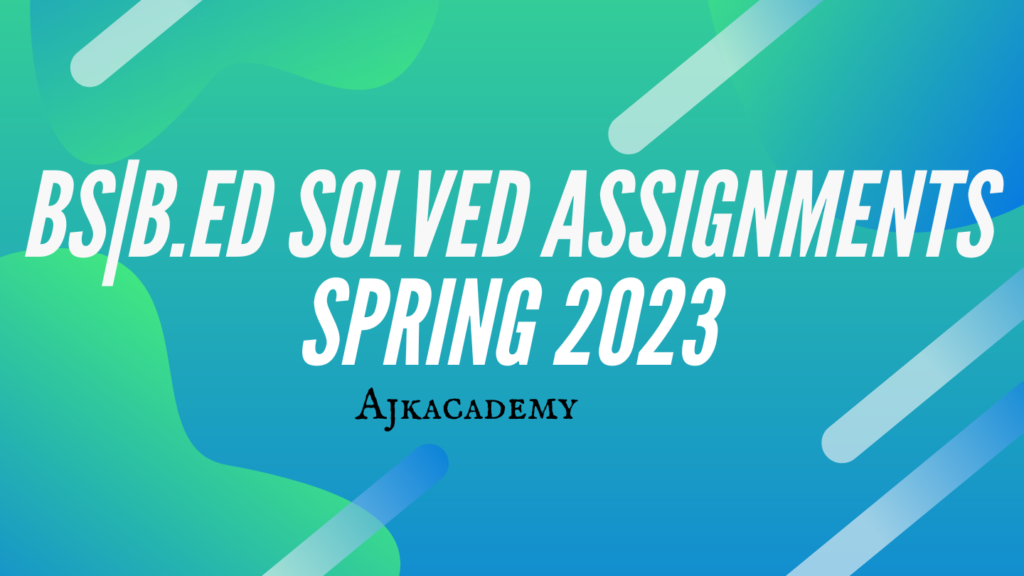
Uses of ICT in Science Education 6439 Solved Assignment spring 2023 1 and 2 free download free pdf
Course: Uses of ICT in Science Education (6439) Semester: Spring, 2023
Level:B.Ed.4Year
Assignment no1
Q1: Different Types of E-Learning for Science Education
E-learning has revolutionized education, and in the realm of science education, it offers numerous ways to engage students effectively. Here are some different types of e-learning methods tailored to the teaching of science:
- Online Courses and Webinars: Interactive online courses and webinars allow students to access science-related content from anywhere at their own pace. These courses often include video lectures, quizzes, and assignments to promote active learning.
- Virtual Laboratories: Virtual labs provide a safe and cost-effective environment for students to conduct experiments and explore scientific concepts without the need for physical equipment. This approach enhances hands-on learning while minimizing potential hazards.
- Gamification: Gamification adds an element of fun to science education by incorporating game-based elements into the learning process. Through interactive games, students can deepen their understanding of complex scientific principles.
- Simulations and Virtual Reality: Utilizing simulations and virtual reality technology, students can immerse themselves in lifelike scenarios, helping them grasp abstract concepts in a more tangible manner.
- Mobile Learning (M-Learning): With the widespread use of mobile devices, m-learning has become popular. Science-related apps and mobile-friendly learning platforms enable students to access educational content on the go.
Q2: The Importance of Tools of E-Learning in Science Education
The tools used in e-learning play a pivotal role in enhancing the overall learning experience. They enable educators to create dynamic and interactive content, fostering better engagement among students. One of the most useful tools for teaching science is virtual reality (VR).
Virtual reality takes students beyond the confines of textbooks and traditional classrooms. It allows them to explore complex scientific concepts through a fully immersive and interactive experience. VR can simulate environments that are otherwise inaccessible, such as distant planets, microscopic organisms, or historical events.
By enabling students to visualize scientific principles in a three-dimensional setting, VR promotes deeper comprehension and retention of information. It sparks curiosity and excitement, making science education an enjoyable journey of discovery.
Q3: The Role of Web Pages, HTML, Search Engines, and Exemplary Websites in Science Education
In the realm of science education, web pages, HTML, search engines, and exemplary websites collectively form a robust digital ecosystem that enriches learning experiences.
- Web Pages and HTML: Web pages serve as information hubs where educational content, including scientific resources, articles, and multimedia, can be accessed. HTML (Hypertext Markup Language) is the backbone of web pages, ensuring proper formatting and linking of content.
- Search Engines: Search engines like Google empower students and educators to find relevant and reliable scientific information swiftly. This accessibility to a vast pool of knowledge enhances research capabilities and facilitates fact-checking.
- Exemplary Websites: Exemplary websites, such as those hosted by educational institutions, scientific organizations, and research centers, provide curated and authoritative content. These websites serve as go-to resources for accurate scientific data.
Q4: Benefits and Limitations of Integrated Learning Systems
Integrated learning systems, which combine various educational technologies and resources into a unified platform, offer several advantages in science education:
Benefits:
- Personalization: Integrated systems can adapt to individual learning styles, providing customized learning paths for students.
- Data-Driven Insights: They generate valuable data on student performance, enabling educators to identify strengths and areas of improvement.
- Multimodal Learning: Integrated systems incorporate diverse multimedia elements, catering to different learning preferences.
Limitations:
- Cost: Implementing integrated systems can be expensive, especially for schools with limited budgets.
- Technical Glitches: Technical issues may disrupt the learning process, hindering seamless interactions.
- Teacher Training: Educators need training to leverage the full potential of integrated learning systems effectively.
Q5: Teaching Science with Computer Graphics
Teaching science with computer graphics introduces a new dimension of visual learning. Here are different dimensions of incorporating computer graphics in science education:
- Visualizing Abstract Concepts: Computer graphics can bring abstract scientific concepts, such as cellular processes or atomic structures, to life through visual representations.
- Interactive Models: Interactive graphics enable students to manipulate models and observe changes, fostering a deeper understanding of cause-and-effect relationships.
- Data Representation: Infographics and data visualizations help students comprehend complex scientific data more efficiently.
- Augmented Reality (AR): AR overlays digital information onto the physical world, offering exciting opportunities for interactive learning experiences.
- Science Simulations: Computer-generated simulations allow students to experiment with various parameters, aiding in the exploration of scientific phenomena.
e-learning has transformed science education, offering various methods to engage students effectively. The integration of advanced tools, such as virtual reality and computer graphics, has opened up new avenues for immersive and interactive learning experiences. As we continue to harness the potential of technology, the future of science education looks promising, inspiring the next generation of curious minds to unravel the mysteries of the universe.
